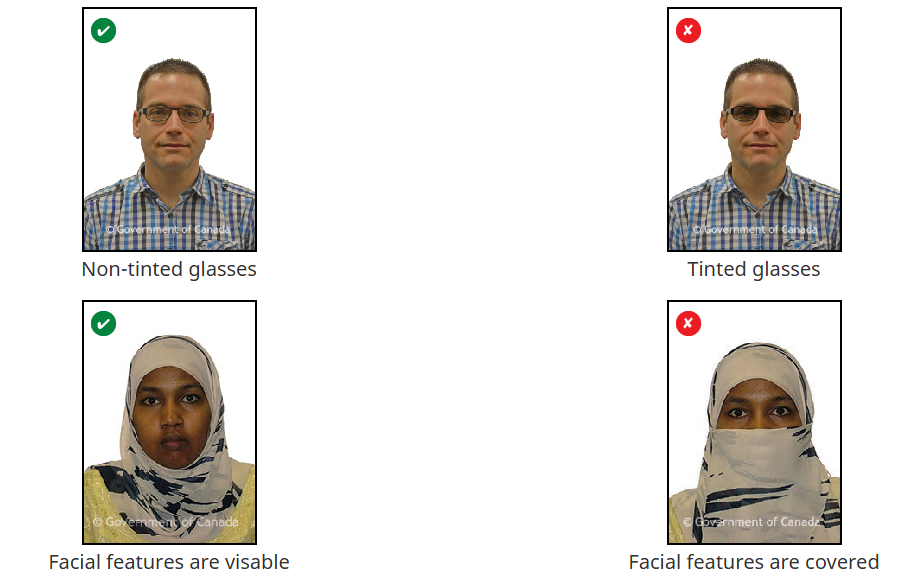Digital photo requirements
Your digital passport photo must:
be taken in person by a commercial photographer
be no more than 6 months before the date you submit your application
NOT be a scanned copy of a printed passport photo
We recommend you ask for both the digital copy of your photo and a printed (physical) copy when you get your photo taken.
Your photo must have:
your face and shoulders centred and squared to the camera
a neutral facial expression:
eyes open and clearly visible
mouth closed, no smiling
uniform lighting:
no shadows, glare or flash reflections
clear, sharp and in focus
natural skin tones
a plain white or light-coloured background with a clear difference between your face and the background
Why you can’t smile on your passport photo
The International Civil Aviation Organization recommends that passport photos be taken with a neutral expression. This lets us use facial recognition systems to help prevent fraud. They electronically verify identity based on each person’s unique facial features.
We accept photos with:
glasses, if your eyes are clearly visible and there is no glare on the lenses
hair down or up
hats and head coverings worn daily for religious beliefs or medical reasons if:
your full face is clearly visible
there are no shadows on your face
We don’t accept photos with:
sunglasses or tinted eye glasses (even when the eyes are clearly visible)
red-eye effect or red-eye alterations
hats and head coverings not worn daily for religious beliefs or medical reasons
Photo and photographer details
When you upload your photo, you must provide:
the studio or photographer’s name
the studio or photographer’s address
the date the photo was taken
Digital photo specifications
The specifications for a digital photo are different from those for a physical photo.
Share these specifications with your photographer when you have your photo taken:
Your photo must be in .jpeg or .jpg format.
The file must be saved directly from the original file captured by the camera.
The photographer can then share it with you by uploading the photo to an online file sharing service, saving it to a USB flash drive or sending it by email, for example.
We don’t accept scanned copies of a printed photo.
The photo may be either in colour or in black and white.
The photo must not be altered.
The image must
have a 3:2 aspect ratio with the camera oriented in portrait mode
be at least 1800 pixels high by 1200 pixels wide
be no larger than 4500 pixels high by 3000 pixels wide
be between 200 KB and 5 MB in size
have a chin to crown (the top of your head) measurement between 45 and 50% of the photo’s height
What is an altered photo?
An altered photo is any photo that has been edited or changed in any way, by any means.
This includes:
technical corrections or enhancements
For example, adjusting colour, brightness, contrast or sharpness.
cropping around the subject’s head and shoulders
For example, cutting and pasting the subject against a white background.
editing facial features
For example, changing size or shape of eyes, nose, mouth or ears.
editing to improve the appearance of the subject
For example, removing glare or red-eye, changing hair colour or eliminating wrinkles, blemishes and birthmarks.
editing the subject’s clothing
For example, changing the clothing’s colours.
changing the background
For example, eliminating shadows.
Examples of acceptable and unacceptable passport photos
These photos are not the actual size of a passport photo.
Unacceptable photos show you what to look for before you submit your application.
Acceptable
Unacceptable



How to take a good passport photo in specific situations
Watch our video about taking passport photos of adults.
If you’re in a wheelchair
Passport photos must be taken against a plain white background. If your wheelchair has a headrest, a plain white covering should be placed over it. This makes your facial features and the edges of your face clear against the background.
If you have headwear or nasal cannula that blocks part of your face
Headwear or a nasal cannula may appear in a passport photo if worn for medical reasons only. Your eyes must remain clearly visible. Include a signed explanation with your application. We may ask for a letter from your doctor.